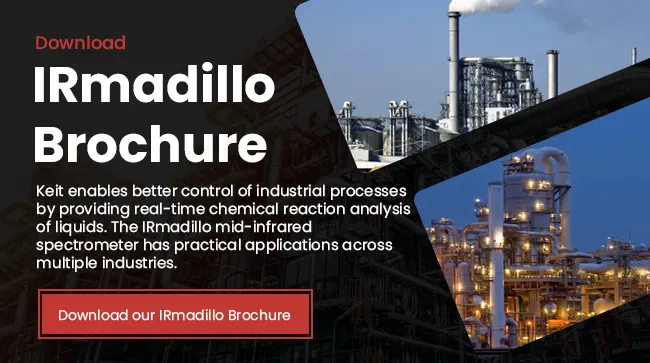The IRmadillo in the Liquefaction Process
Measuring the performance of the fuel ethanol liquefaction process in real time allows the opportunity for constant process optimization. The primary benefits come from optimizing the quantity of enzyme and urea used, and also through optimizing the solid loading to minimize energy used in distillation. In several installations, the IRmadillo spectrometer has proved able to measure the relevant concentrations with levels of accuracy that allow true optimization of the process.
Introduction
In the fuel ethanol production process, mash is pumped to the liquefaction tanks where alpha amylase enzyme is added to break down the flour starch into long chain sugars, and ammonia (in the form of urea) is added as a nitrogen source for the yeast in the subsequent fermentation. Solids loading should be optimized to increase ethanol production per fermenter and to minimize the amount of water that subsequently needs to be heated in the distillation process. Bacterial contamination can be a significant source of yield loss and can be identified through lactic and acetic acid build up in the liquefaction stage. In addition, there is a need to identify fuel contamination, which may arise from the recycled backset water, and which can constrain fermentation and reduce ethanol yields.
Figure 1
Spectrometers allow continuous and detailed measurement of chemical concentrations in real time. Many process spectrometers are based on near infrared light, which is fundamentally less informative than mid infrared light. Conventional mid infrared spectrometers (which often use a Fourier transform and so are referred to as "FTIR spectrometers") have sensitive moving parts and fragile fiber probes – making them wholly unsuitable for production environments such as ethanol refineries.
The IRmadillo is a process analyzer built using FTIR spectroscopy, but with static optics, removing the need for moving mirrors or fiber probes, and dramatically improving stability, reliability, and ruggedness.
Example use case
This application note presents data from an ethanol refinery in Iowa, measuring the concentration of ethanol and other components at the exit of the liquefaction tanks. The data generated is presented in Table 1 below. The measurement accuracy and reliability has enabled the plant to control enzyme dosage and solids loading to optimize the performance of the liquefaction process.
Table 1: Measurement accuracy for sugars and other species of interest in liquefaction.
Real Time Measurement
Using chemometric models, the IRmadillo was "trained" to measure the key species of interest: DP1,2,3&4, Glycerol, and Lactic and Acetic acids. The IRmadillo then outputs, direct to the DCS, the concentration values of each of those species, generating a reading every 2 minutes. The resulting trend lines fill in the blind spots between HPLC sample data points, allowing the operators to identify deviations from the desired process as they happen, not after the event.
Figure 2: Measurements of species of interest at the exit from the liquefaction tank showing the trend lines over time available to the process controllers. Grey points are the output of the IRmadillo spectrometer. The red points are the measured samples from offline HPLC.
Conclusions
The IRmadillo spectrometer is able to measure, in real time, the key components of interest in liquefaction, enabling the optimization of the enzyme usage, solid loading and detecting contaminants before transfer to fermentation. The measurements are well within the useable range and can be used both to understand and control the process.
Keep in Mind
The IRmadillo can be calibrated to measure a large range of chemicals at the same time. This work shows the use for DP4, DP3, DP2, DP1, lactic and acetic acids, glycerol, and ethanol measurement. We also measure acetal, methanol, and propanol levels, but the IRmadillo can also be calibrated to measure applications in ethanol propagation, FAN, PAN and fusels in fermentation – all at the same time, in real-time.


